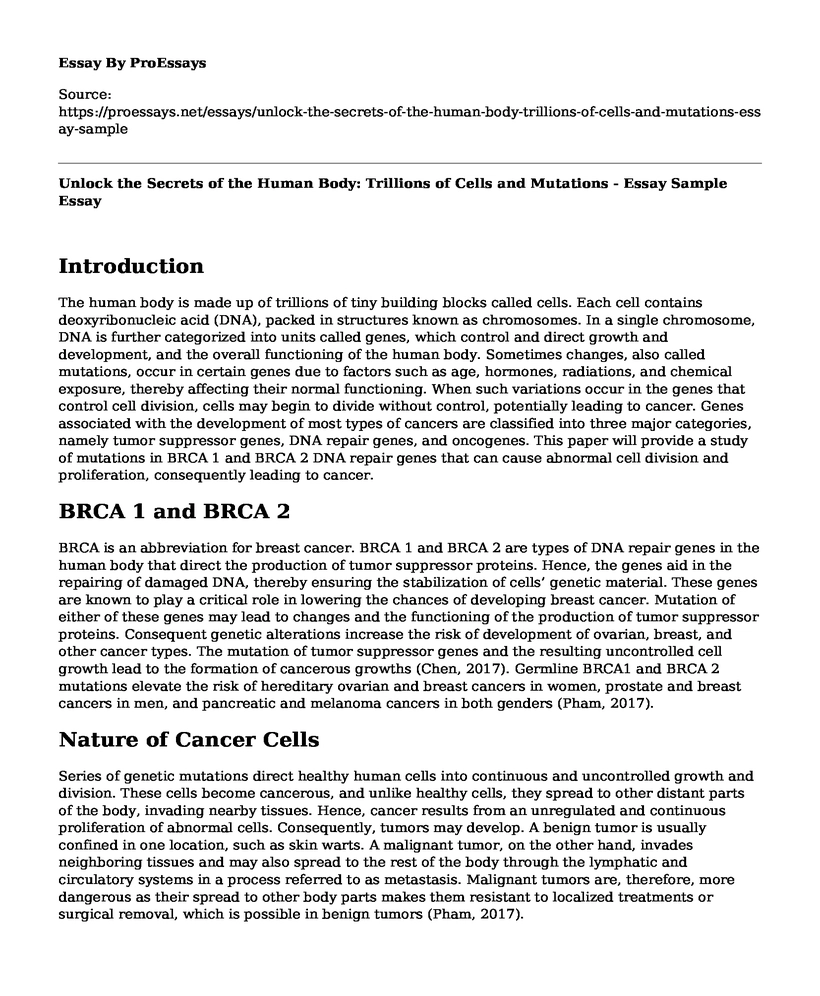Introduction
The human body is made up of trillions of tiny building blocks called cells. Each cell contains deoxyribonucleic acid (DNA), packed in structures known as chromosomes. In a single chromosome, DNA is further categorized into units called genes, which control and direct growth and development, and the overall functioning of the human body. Sometimes changes, also called mutations, occur in certain genes due to factors such as age, hormones, radiations, and chemical exposure, thereby affecting their normal functioning. When such variations occur in the genes that control cell division, cells may begin to divide without control, potentially leading to cancer. Genes associated with the development of most types of cancers are classified into three major categories, namely tumor suppressor genes, DNA repair genes, and oncogenes. This paper will provide a study of mutations in BRCA 1 and BRCA 2 DNA repair genes that can cause abnormal cell division and proliferation, consequently leading to cancer.
BRCA 1 and BRCA 2
BRCA is an abbreviation for breast cancer. BRCA 1 and BRCA 2 are types of DNA repair genes in the human body that direct the production of tumor suppressor proteins. Hence, the genes aid in the repairing of damaged DNA, thereby ensuring the stabilization of cells’ genetic material. These genes are known to play a critical role in lowering the chances of developing breast cancer. Mutation of either of these genes may lead to changes and the functioning of the production of tumor suppressor proteins. Consequent genetic alterations increase the risk of development of ovarian, breast, and other cancer types. The mutation of tumor suppressor genes and the resulting uncontrolled cell growth lead to the formation of cancerous growths (Chen, 2017). Germline BRCA1 and BRCA 2 mutations elevate the risk of hereditary ovarian and breast cancers in women, prostate and breast cancers in men, and pancreatic and melanoma cancers in both genders (Pham, 2017).
Nature of Cancer Cells
Series of genetic mutations direct healthy human cells into continuous and uncontrolled growth and division. These cells become cancerous, and unlike healthy cells, they spread to other distant parts of the body, invading nearby tissues. Hence, cancer results from an unregulated and continuous proliferation of abnormal cells. Consequently, tumors may develop. A benign tumor is usually confined in one location, such as skin warts. A malignant tumor, on the other hand, invades neighboring tissues and may also spread to the rest of the body through the lymphatic and circulatory systems in a process referred to as metastasis. Malignant tumors are, therefore, more dangerous as their spread to other body parts makes them resistant to localized treatments or surgical removal, which is possible in benign tumors (Pham, 2017).
Cancer Cell Invasion and Migration
Metastasis is regarded as the primary cause of cancer-related deaths. The migration may involve collective cell metastasis, where cells move together to invade tissues in the surrounding. The mechanism for this type of movement uses a leader-follower behavior (Yang et al. 2019). Cancer cells usually detach from the primary cell tumor mass. The cells disseminate through either the lymphatic or the blood vessels, maintaining intercellular junctions. Scientific models in cancer invasion studies reveal that cancer cells usually rearrange into leader-follower positions. The density of the surrounding tissue collagen matrices requires high energy uptake for the leading cells. After depletion of the available energy, follower cells sustain the invasion by taking the leader-cell positions (Zhang et al. 2019). This metastasis mechanism makes cancer treatment a challenge.
Conclusion
BRCA1 and BRCA 2 are some types of DNA repair genes that play a critical role in the prevention of breast and ovarian cancers. The genes also lower the risk of developing other types of cancers, including prostate, pancreatic, and melanoma. The primary role of BRCA genes is to facilitate the production of tumor suppressor proteins, which help repair damaged DNA. BRCA genes mutations, therefore, may lead to an abnormal cell division and proliferation. Cancer cell invasion to the surrounding tissues may result, and a further spread to other parts of the body, mainly through the circulatory and lymphatic systems.
References
Chen, C. (2015). Advances in DNA repair. Rijeka: IntechOpen.
Pham, P. V. (2017). Breast cancer: From Biology to Medicine. Rijeka: IntechOpen.
Yang, Y., Zheng, H., Zhan, Y. & Fan, S. (2019) An emerging Tumor invasion mechanism about the collective cell migration. American Journal of Translational Research, 11(9), 5301-5312. https://www.ncbi.nlm.nih.gov/pmc/articles/PMC6789225/pdf/ajtr0011-5301.pdf
Zhang, J. et al. (2019) Energetic regulation of coordinated leader-follower dynamics during collective invasion of breast cancer cells. Proceedings of the National Academy of Science, 116(16), 7867-7872. doi.org/10.1073/pnas.1809964116T
Cite this page
Unlock the Secrets of the Human Body: Trillions of Cells and Mutations - Essay Sample. (2023, Aug 27). Retrieved from https://proessays.net/essays/unlock-the-secrets-of-the-human-body-trillions-of-cells-and-mutations-essay-sample
If you are the original author of this essay and no longer wish to have it published on the ProEssays website, please click below to request its removal:
- Essay Sample: Smart Homes and Their Role in Home Healthcare
- Research Paper on the Health Care Issue: Nursing Shortage
- Analysis of Sources on Youth Risk Behavior Paper Example
- Risk Factors for Coronary Artery Disease in Postmenopausal African American Women
- The Real Cost Campaign by The Food and Drug Administration Essay
- Forensic Nursing: A Creative & Developing Nursing Specialty - Essay Sample
- Care Coordination Model - Report Example







